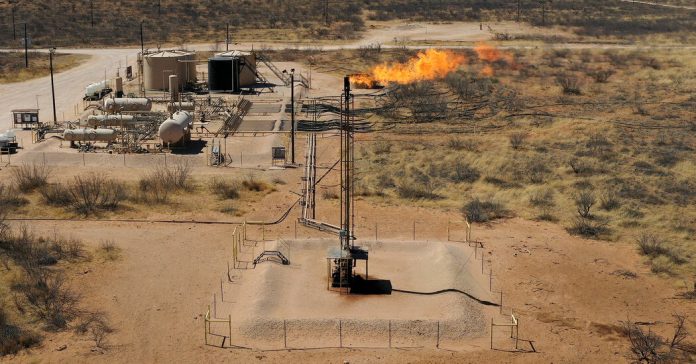America’s greenhouse gasoline emissions from power and business elevated 1.3 % in 2022, persevering with to rebound from an abrupt pandemic decline in 2020 however not fairly reaching prepandemic ranges, in accordance with preliminary estimates printed Tuesday by the Rhodium Group, a nonpartisan analysis agency.
Emissions ticked up at the same time as renewable power surpassed coal energy nationwide for the primary time in over six many years, with wind, photo voltaic and hydropower producing 22 % of the nation’s electrical energy in contrast with 20 % from coal. Progress in pure gasoline energy era additionally compensated for coal’s decline.
The brand new estimate places nationwide emissions again in keeping with their long-term trajectory after practically two years of Covid-related disruptions, mentioned Ben King, an affiliate director on the Rhodium Group and an creator of the report.
“We’re primarily on the identical trajectory that we’ve been on for the reason that mid 2000s,” he mentioned, calling it a “long-term structural decline,” however one which’s “not occurring quick sufficient.”
Perceive the Newest Information on Local weather Change
The way forward for the Amazon. Some Brazilian scientists learning the focus of carbon dioxide within the Amazon concern that the rainforest, one of the biodiverse ecosystems on Earth, could develop into a grassy savanna in a matter of many years — with profound results on the local weather worldwide.
Two years in the past, President Biden promised to speed up the tempo, setting a aim of lowering the nation’s greenhouse gasoline emissions a minimum of 50 % beneath 2005 ranges by 2030, an quantity that’s regarded as in keeping with limiting world warming to 1.5 levels Celsius (2.7 levels Fahrenheit) above preindustrial ranges. Past that threshold, scientists say the chance of local weather disaster, together with life-threatening warmth waves and meals and water shortage, will increase considerably. The planet has already warmed 1.1 levels Celsius over the previous century.
However the Rhodium Group’s evaluation suggests the nation shouldn’t be on observe to satisfy Mr. Biden’s goal:
The just lately handed Inflation Discount Act, a landmark local weather and tax regulation, is meant to assist bend the emissions curve nearer to the 2030 aim, however even it’s prone to fall brief.
The emissions estimate displays a continued rebound from 2020 pandemic lows. The preliminary outbreak of the coronavirus triggered widespread lockdowns and slashed U.S. power use to its lowest degree in many years, with emissions plummeting greater than 10 %. They rebounded 6.2 % in 2021 because the economic system started to bounce again, however ongoing provide chain disruptions and new coronavirus variants dampened the restoration. The smaller rise in 2022 emissions got here amid Russia’s battle in Ukraine, the ensuing world power disaster, and excessive inflation.
Emissions from electrical energy era fell as renewable power and pure gasoline displaced coal, which noticed a small and short-lived improve in 2021 due to excessive pure gasoline costs. Pure gasoline is much less carbon-intensive than coal, however burning it produces way more methane, a very potent greenhouse gasoline.
A latest report from the Worldwide Vitality Company estimated that renewables are on observe to overhaul coal as the most important supply of electrical energy era worldwide by early 2025, as international locations reply to fossil gasoline provide disruptions linked to the battle in Ukraine by enacting stronger insurance policies to shift away from carbon-emitting oil, gasoline and coal.
Nonetheless, america made little progress final yr in both of its highest-emitting sectors, transportation and business, which collectively account for roughly two-thirds of the nation’s complete greenhouse gasoline emissions. Industrial emissions rose by 1.5 % and transportation emissions rose by 1.3 %, the latter pushed primarily by demand for jet gasoline as air journey continued to get better from pandemic-era declines.
Some specialists are hopeful that provisions within the Inflation Discount Act can present cash to assist velocity decarbonization at industrial vegetation and cut back fossil gasoline emissions from heavy business, together with cement and metal manufacturing. The laws additionally expanded client tax credit for electrical automobiles, which usually create fewer emissions than gasoline-powered automobiles.
Essentially the most vital improve in emissions final yr got here from houses and buildings, which burn fossil fuels like pure gasoline in furnaces, scorching water heaters and different home equipment. These emissions rose 6 %, and reached prepandemic ranges. Colder-than-average temperatures early within the yr led many People to extend their house power use by turning up the warmth.
The estimates from the Rhodium Group don’t embody emissions from agriculture or from wildfires, which launch carbon dioxide into the environment as they burn forests and grasslands. Agriculture is a serious contributor to local weather change, with farming actions accounting for 11.2 % of complete greenhouse gasoline emissions in america in 2020, in accordance with estimates from the U.S. Division of Agriculture.
The report does comprise some excellent news: Final yr, the nation’s financial progress, measured in G.D.P., outpaced emissions progress, indicating that the economic system was much less carbon intensive, Mr. King mentioned. This “decoupling” of financial progress from fossil gasoline consumption is essential in charting an economically sustainable path towards decarbonization.
“We’ve seen the challenges that occur when declines in emissions are tied to declines in G.D.P.,” he mentioned. “Take a look at 2020.”


